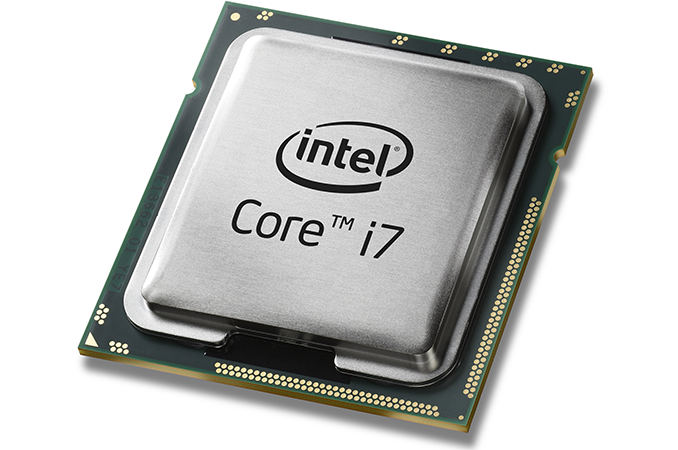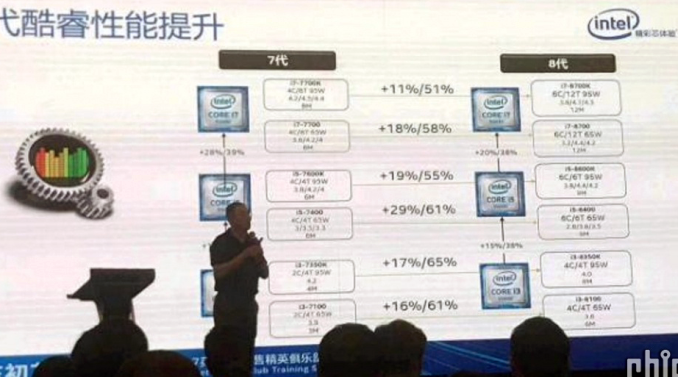Intel Provides Partners Preliminary 8th Gen Desktop Details: Core i7-8700K to Core i3-8100
by Anton Shilov on August 18, 2017 9:15 AM EST- Posted in
- CPUs
- Intel
- Core i5
- Core i7
- Core i3
- 14nm
- Core 8th Gen
- Coffee Lake

At a closed-session partner in China, Intel revealed a number of preliminary details about its upcoming 8th generation Core processors for desktops. As expected, Intel is telling its business customers that is increasing core count of its CPUs for mainstream PCs in a bid to drive performance, catalyze upgrades and better compete against its rival.
Intel has previously unveiled that they're working on what will be their 8th Generation Core processors. What has been rumored for a while (and what Intel yet has to publicly confirm) is increased core counts for the 8th Gen desktop parts. This week Chiphell, a China-based website, published a picture taken from a partner briefing event, which briefly describes the advantages of Intel’s 8th gen Core CPUs vs the company’s 7th gen Core chips.
According to two separate external sources with knowledge of the matter, the slide is up-to-date and genuine.
Intel is stating that the increased number of cores and enlarged caches will be the key improvements of the 8th Gen desktop parts, compared to their direct predecessors. In particular, the event speaker explained that the next-gen Core i7-8000 series CPUs will gain two additional cores to give six cores with Hyper-Threading. At the top end, it was stated that these will be at 95W and 65W TDPs for unlocked and regular SKUs respectively. The Core i5 series will also get two additional cores, but no Hyper-Threading. As for the Core i3 parts, these parts will lose Hyper-Threading, but instead move into the traditional i5 space, giving four cores only. Intel stated that they will also continue to offer unlocked CPUs within its i7, i5 and i3 families, and such processors will feature higher frequencies and a 95 W TDP (compared to the 65 W thermal envelope for their regular parts).
Update 9/15: Adding previously unknown frequencies.
| Basic Specifications of Intel Core i5/i7 Desktop CPUs | |||||||||||
| 7th Generation | 8th Generation | ||||||||||
| Cores | Freq. (Base) |
L3 | TDP | Cores | Freq. (Base) |
L3 | TDP | ||||
| i7-7700K | 4/8 | 4.2GHz | 8 MB | 91W | i7-8700K | 6/12 | 3.8GHz | 12MB | 95W | ||
| i7-7700 | 3.6GHz | 65W | i7-8700 | 3.2GHz (?) | 65W | ||||||
| i5-7600K | 4/4 | 3.8GHz | 6 MB | 91W | i5-8600K | 6/6 | 3.6GHz (?) | 9 MB | 95W | ||
| i5-7400 | 3.0GHz | 65W | i5-8400 | 2.8GHz | 65W | ||||||
| i3-7350K | 2/4 | 4.2GHz | 4 MB | 60W | i3-8350K | 4/4 | 4.0GHz | 6MB | 95W | ||
| i5-7100 | 3.9GHz | 51W | i3-8100 | 3.6GHz | 65W | ||||||
As it stands, three things remain unclear about the 8th generation Core processors for desktops. The first one is the integrated graphics configuration of the company’s upcoming parts, as it may be important if Intel increases their GPU core counts to keep performance growing. The second one is the CPU core configuration of the future Pentium SKUs. In the case of Kaby Lake-based Pentiums, Intel enabled Hyper-Threading technology to match the Core i3 parts, blurring the line between the i3-7000 and the Pentium G4600-series parts. Third is if there are any adjustments to the pricing structure.
What will be interesting is the fact that Intel has lost the 4C/8T level of hardware. By moving the Core i5 to a six-core, any 4C/8T component has the potential to surpass a 6C/6T in certain tests.
Intel did not supply us with this information. Intel traditionally does not comment on information it reveals to partners behind closed doors. More importantly, the information should be considered as preliminary as the company has been known to change product specifications close to launch, even on final engineering samples to retail. Even though the 8th generation Core processors would already need to be in production in order to meet Intel's 2017 goals, last minute changes are always on the table. Similarly, Intel has a lot of latitude in deciding when to actually launch their parts, particularly lower-volume desktop parts.
Related Reading:
Source: ChipHell











55 Comments
View All Comments
jaydee - Friday, August 18, 2017 - link
So essentially, i5-7600 = i3-8100. Real curious to see the actual power draw and pricing.milkywayer - Friday, August 18, 2017 - link
Suddenly we see Intel become generous. Blessing us with two extra cores at the 4 core processor point after years.Amazing what a small kick in the ass from a competitor can achieve. Yeah,
I'm still salty over the $1700 price on 10core cpu last year.
HollyDOL - Friday, August 18, 2017 - link
There is veru little chance this would be a reaction on Zen. Developing a cpu is not a thing that can be done overnight.Imho Ice Lake announcement would be time wise closest to be able to fit in new cpu as a reaction to the competition (not talking about rebranded Xeons).
HollyDOL - Friday, August 18, 2017 - link
very*Where's the edit button?
Notmyusualid - Saturday, August 19, 2017 - link
Agreed, people who think Intels' releases are all Ryzan-based reactions are on drugs - hopium.If they watched some of the Intel University etc talks on a well-known video site, they too would see CPUs are not 6-month projects.
Notmyusualid - Saturday, August 19, 2017 - link
DAM the edit button, or lack thereof!I wanted to add that PRICE adjustments, may well be Ryzen inspired. Not products, just yet.
iphadke - Monday, August 21, 2017 - link
Zen details has been known for years, why wouldn't this be Intel's reaction to AMD? What good reason did they have before May 2017 to give more physical cores for the same price?0ldman79 - Tuesday, August 22, 2017 - link
I don't think anyone is claiming that Intel developed a six core CPU in response to AMD.It is very likely that they *released* a six core CPU in response to AMD though.
It would be incredibly short sited for Intel to not have other chips on the back burner with or without AMD as competition.
masouth - Tuesday, August 22, 2017 - link
Not all Intel releases are necessarily Ryzen-based reactions but this one seems pretty obvious that it is.Intel has been able to go more cores for years but AMD didn't push them for a reason to so they used the "extra" space trying to improve that integrated graphics sacred cow that they seem to feel is required for all the i series chips and why bother offering an option without it because people don't have another choice.
The simple fact is that AMD finally provided a marketing reason to start offering more cores when even Ryzen's low end is shipping with 4 or more cores.
A rising tide lifts all boats....that don't sink first.
azazel1024 - Friday, August 18, 2017 - link
And why wouldn't it be? It isn't like Intel hasn't known AMD has been developing Zen for at least a couple of years now. Even ignoring any actual industrial espionage AMD has been stating their expectations of the new architecture for awhile. So between that, rumors/leaks and possibly some unscrupulous behavior (possible, but unlikely) Intel probably had some good guesses on the shape of Zen.